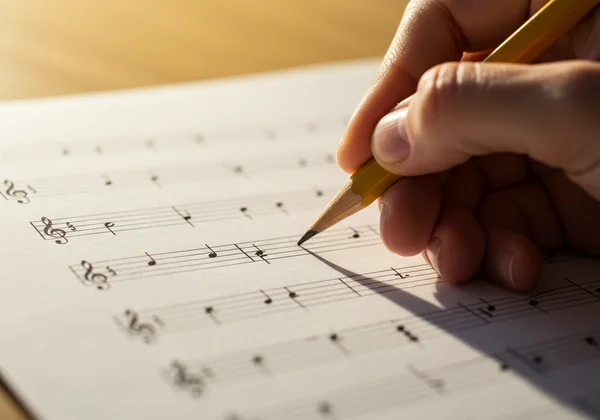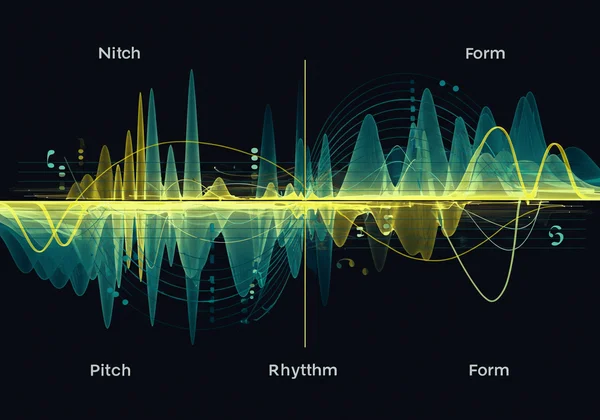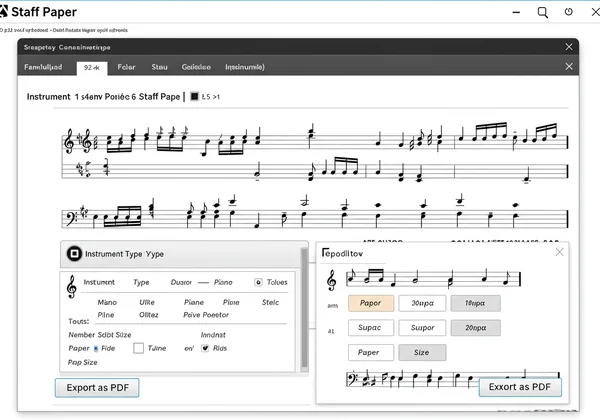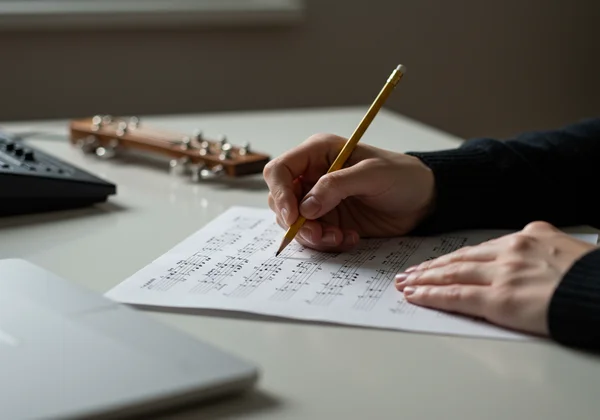Compose Your First Melody: A Staff Paper Guide
Have you ever hummed a tune you created and wished you could write it down? Many aspiring musicians dream of composing their own music, but the blank page can feel intimidating. This guide will show you just how simple it can be to write melodies, especially with the right tools—starting with a clean sheet of staff paper. How do I write my own music melody? It all begins with a single note, and we're here to help you find it. Get ready to turn your musical ideas into tangible art with our free printable staff paper.

Understanding Melody Writing Basics
Before you put a pen to paper, it helps to understand what makes a melody memorable. A melody is more than just a random sequence of notes; it's a musical sentence that tells a story. Great melodies are singable, have a clear direction, and create an emotional connection with the listener. They are the heart of a song, the part that gets stuck in your head for days.
What Defines a Captivating Melody?
What makes a melody truly captivating? Often, it's a distinct shape or contour – how it gracefully moves up and down, feeling both logical and delightfully surprising. Think of "Twinkle, Twinkle, Little Star"—it starts with a jump up, then steps down, creating a simple, pleasing arc. This balance between stepwise motion (moving to an adjacent note) and leaps (jumping over notes) is a key ingredient in effective melody building. The goal is to create a line that is interesting yet easy for the ear to follow.
The Core Elements: Pitch, Rhythm, and Form
To craft a melody, you'll be working with three fundamental building blocks. Understanding these concepts is essential for your songwriting basics.
-
Pitch: This refers to how high or low a note sounds. On staff paper, notes placed higher on the five lines and four spaces represent higher pitches. The combination of different pitches creates the melody's contour.
-
Rhythm: This is the timing and duration of the notes. Rhythm gives a melody its pulse and energy. A series of notes with the same pitch can sound completely different just by changing the rhythm.
-
Form: This is the overall structure of your melody. Most melodies are built from smaller phrases that repeat or contrast with each other. A common structure is AABA, where the 'A' sections are similar and the 'B' section provides contrast.

Preparing Your Canvas: Printable Staff Paper for Composers
Your creativity needs a place to flourish, and that's where blank sheet music comes in. While digital software is powerful, the simple act of writing by hand connects you directly to your music without the barrier of a screen. It’s an immediate, intuitive way to capture fleeting inspiration, making it an essential tool for both students and seasoned composers.
Why Use Blank Staff Paper for Your Compositions?
Using blank manuscript paper encourages focus. Without the distractions of a computer, you can fully immerse yourself in the creative process of music composition. It allows for quick edits, doodles in the margins, and a tangible record of your progress. Furthermore, preparing your own staff paper exercises helps you internalize the fundamentals of music notation. You become more familiar with clefs, key signatures, and time signatures when you are setting them up yourself.
How to Get Your Free Custom Staff Paper from StaffPaper
Gone are the days of rushing to the store for an expensive manuscript book. StaffPaper provides a completely free and highly customizable online tool to generate the perfect staff paper for your needs. Whether you need standard lines for a vocal melody, a grand staff for piano staff paper, or a staff with tablature for guitar staff paper, you can create it in seconds.
Here’s how easy it is:
- Visit the homepage.
- Select your instrument or staff type (e.g., Piano, Guitar, Choir).
- Choose your clef, the number of staves per page, and paper size (A4 or Letter).
- Preview your custom design in real-time.
- Click "Export as PDF" to instantly download your high-quality, print-ready file.
It’s that simple. You can customize your manuscript paper to fit any project, from a simple classroom exercise to a full orchestral score.

Step-by-Step Music Composition on Staff Paper
With your custom staff paper pdf printed and ready, it's time for the fun part: writing your first melody. Don't worry about making it perfect; the goal is to get your ideas out. The best way to learn is by doing.
Brainstorming Your Initial Musical Idea
Where do melodies come from? They can start from anywhere! Hum a tune while you're walking, play a few random notes on an instrument, or try setting a line from your favorite poem to music. The key is to find a short, simple musical idea—a motif—that feels interesting to you. Once you have a small fragment, you can develop it into a full melody.
Developing Pitch: Using Scales & Intervals for Melody Building
Most melodies are built from the notes of a specific scale (like C Major or A minor). Start by choosing a simple scale and experiment with arranging its notes. Try moving mostly by steps with an occasional leap for excitement. A good exercise is to create a "question" phrase that ends on an unstable note (like the second or seventh degree of the scale) and an "answer" phrase that resolves back to the tonic, or root note.
Adding Rhythm and Flow to Your Notes
Once you have a sequence of pitches, give them life with rhythm. Tap out a beat on your desk and try fitting your notes to it. Vary the length of your notes—use a mix of quarter notes, half notes, and eighth notes. Pay attention to how the rhythm creates a sense of forward motion. Good rhythm should feel as natural as speech. This is a core part of effective composing tips.
Refining and Expanding Your Melody
Your first draft is just the beginning. Play your melody on an instrument or sing it aloud. Does it flow well? Are there any awkward spots? Don't be afraid to change notes, adjust rhythms, or even start over. Once you have a phrase you like, try repeating it, changing it slightly (a technique called variation), or writing a contrasting phrase to follow it. This is how you build a simple motif into a complete musical thought.

Essential Composing Tips for Aspiring Songwriters
As you continue your journey in music composition, keep these guiding principles in mind. They will help you overcome creative blocks and develop your unique voice as a songwriter.
Listen Critically to Music You Love
The best composers are also the best listeners. When you listen to your favorite songs, don't just enjoy them—analyze them. What makes the melody so effective? How does it interact with the harmony and rhythm? Try to transcribe simple melodies you hear onto your blank music staff paper; it's one of the best ways to learn.
Start Simple and Build Complexity
Don't try to write a symphony on your first day. Your first melodies might be just eight bars long, and that's perfectly fine. The goal is to master the fundamentals of creating a clear, concise musical statement. As you gain confidence, you can explore more complex harmonies, rhythms, and forms.
Don't Be Afraid to Experiment and Iterate
There are no mistakes in creativity, only opportunities. Some of your ideas won't work, and that's a natural part of the process. The freedom of having an unlimited supply of free staff paper means you can experiment without worry. Write, scribble, erase, and rewrite. Every attempt is a step forward.

Start Composing Today: Your Melody Awaits!
Armed with this foundational knowledge and the perfect tool at your fingertips, your composition journey is ready to begin. The only thing standing between the music in your head and a tangible score is that crucial first step: picking up a pencil and making your mark on the page.
Your unique musical voice is waiting to be discovered. Don't let anything hold you back. Head over to our website, download your paper now, and write the melody that only you can create.
Frequently Asked Questions About Composing & Staff Paper
What is staff paper called in music?
Staff paper is also commonly known as manuscript paper or music paper. The term "staff" refers to the set of five horizontal lines and four spaces where musical notes are written. It is the standard format for Western musical notation.
Where can I get free printable staff paper?
You can get high-quality, free printable staff paper right here on our website. Our site offers a powerful and easy-to-use tool that lets you customize your paper for any instrument or need—from piano to choir to guitar—and download it instantly as a PDF file at no cost. Get your free staff paper and start writing today.
How do I write my own music melody?
To write your own melody, start with a simple musical idea or motif. Use the notes from a scale you are comfortable with and arrange them into a pleasing shape. Focus on creating a balance between stepwise motion and leaps, and give your notes a clear rhythm. Most importantly, experiment freely on your manuscript paper until you find something you love.
How many lines are on a typical staff paper?
A standard musical staff has five parallel horizontal lines and four spaces. Each line and space represents a different musical pitch, which is determined by the clef (such as the Treble or Bass clef) placed at the beginning of the staff. For instruments like the piano, two staves are often joined together to form a "grand staff." You can generate all these formats at our online tool.